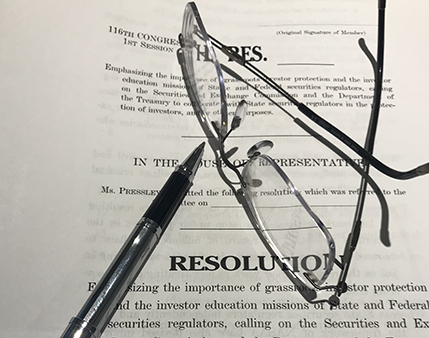(April 29, 1999) – Overall America’s securities markets are fair, open and transparent and have the confidence of investors. NASAA believes that this is in large part because of our 60-year old complementary regulatory regime of state, industry and federal oversight and enforcement. This three-legged regulatory stool is a major reason why the US securities markets are the envy of the world. The SIA’s proposals on broker licensing, if they became law, would remove one leg of this stool.
Typically, state regulators see and act on problems before other regulators, acting like an early-warning radar system. Two examples of this: States were the first to take steps against “microcap” stock fraud and, more recently, to raise concerns about day trading firms.
Securities markets are increasingly global but securities sales are local; increasingly stocks and bonds are bought on Main Street by middle-class Americans. States need to be able to protect their citizens from fraud.
State securities regulators have worked to create a new regulatory landscape, both in the wake of the National Securities Markets Improvement Act of 1996 (“NSMIA”) and generally in reaction to the evolution of the American financial marketplace. The states work closely with the Securities and Exchange Commission (“SEC”) to protect individual investors and promote fair markets.
As the “local cop on the beat,” as SEC Chairman Arthur Levitt calls us, state securities agencies:
- use their traditional licensing authority to screen broker applications and regulate stockbrokers, more than 90% of whom on average are calling potential investors from out-of-state. While the vast majority of stockbrokers are honest and ethical, this licensing authority is an essential tool in protecting state investors from bad brokers and cold calling stock salesman peddling junk securities who prey from out-of-state on vulnerable, naïve victims.
- took on primary responsibility, at the direction of Congress, for the licensing and regulation of thousands of smaller investment advisers, including the financial planners who help investors deal with today’s and tomorrow’s investment challenges. An important advance is the states’ development and, in the next several months, implementation of a competency exam for investment adviser representatives, the individuals who will be licensed to provide advice, providing for the first time at least base-level competence before they can practice; and
- in cooperation with the National Association of Securities Dealers (“NASD”), an industry self-regulatory organization, maintain a database with information about stockbrokers (and in the future, investment adviser representatives) to help their citizens make intelligent, well-informed decisions about those with whom they conduct their investment business, based on full disclosure of disciplinary and employment background. Note: The new Web-based Central Registration Depository (CRD) will speed up licensing of brokers with no disciplinary problems, making it virtually instantaneous.
It is in the midst of this evolution and development over the last three years that the Securities Industry Association (“SIA”) has recommended to the staff of the Senate Banking Committee that, essentially, much of it be dismantled. NASAA fears that were the SIA proposals to become law:
- States would be limited to licensing only those stockbrokers who have a place of business in their state, not out-of-state agents calling in; this would set off a “race to the bottom” with rogue brokers and bad firms migrating to states with weak laws and limited regulatory resources, where they could prey on investors nationwide. Other professionals such as lawyers and doctors are licensed by the states where they have clients and patients. Would it make sense for a doctor in New Jersey, say, to treat by phone a patient he’d never met in Utah and not give Utah regulators any authority to protect that patient from harm? If states are unable to keep bad brokers and firms out of their jurisdictions—if the local cop on the securities beat is handcuffed—we could see a renaissance of boiler room operators who plundered so many investors in years past.
- States could not impose their own licensing qualifications on individual financial planners greater than those already imposed by the SEC. The SEC currently has virtually no regulatory structure in place for the individuals who work for investment advisers. This was one of the fundamental reasons for the division of authority over investment advisers under NSMIA. Among the potential impacts of the proposal would be the elimination of the competency exam three years in development and now only months away from implementation; and
- The NASD would have significant control over the information made available (disciplinary records, employment history, test scores) about stockbrokers to investors (and possibly investment adviser representatives) and could have the power to decide what should and should not be collected and disclosed to the states and the general public. In other words, an industry self-regulatory organization could be given the power to decide what is and what is not a state public record.
NASAA recognizes the importance of efficient regulation and there are some features of the SIA proposals the states support. Uniform treatment of foreign securities would improve market efficiency. In fact, NASAA made a similar proposal to the Banking Committee staff several weeks ago (available from the NASAA corporate office). The same is true for treatment of rights and warrants as covered securities. Finally, the proposed study of self-regulatory organizations would be worthwhile and significant.
State securities regulators support thoughtful reforms that will make our markets more efficient—but not at the expense of investor protection.










